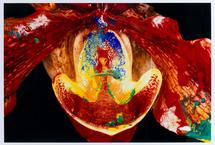This is perhaps the most polemic genre within Art History. Already during the classic era the human body constituted the raw material that generated a common interest among all art disciplines -painting, sculpture and photography. Nevertheless, the obstacles to represent it have been innumerable. Controversy has developed around the subject as a result of the constant prohibitions it faced -and still faces- and for the attraction that the natural body exercises per se. In turn, these restrictions have managed to build an exceedingly interesting artistic theme out of the topic. It wasn’t till the second decade of the 20th Century that the costumes became more natural and therefore the mentality more open towards this type of subject matter. Further, the discipline of photography has benefited from the influx of these changes postulating itself as an autonomous artistic genre. These images open a new path of creative experimentation in which the nude dissociates itself from both moral censure and secrecy. As a result, the subject of the nude has reached in recent years a stable situation.
Galería Javier López presents in this occasion artwork by the following authors:
NOBUYOSHI ARAKI (Tokyo, 1940) is probably the most recognized Japanese photographer inside and outside his country. Collaborator in magazines such as Playboy or Déjà-Vu, this prolific artist, has made the female world the central theme of his work since the start of his career. The development of the topic is charged with an eroticism that is sometimes perturbing captured for example in his images that present portraits of artistically tied up women. These overtly sexual portraits as well as his nude images combine both tradition and modernity. Furthermore, this type of work blends itself with daily and urban series and other images such as the ones that portray the juxtaposition of the notions of life or death in Tokyo. Although, some consider the artist a pornographer, due to the explicit content in his images, and others like feminist groups regard him as misogynist; there are those who value the modernity with which his work addresses both the subject of the nude and the play with perversion. Opinions of him range, especially towards works like Tokyo Diaries charged with an overtly present eroticism and plasticity, making him one of the most controversial artists alive.
MAPPLETHORPE (New York, 1946 – Boston, 1989) is seen as a leading exponent of Counterculture. His groundbreaking, erotic, and, overtly sexual work, allows for both dislike and adoration. Mapplethorpe’s obsession with perfectionism and extreme aestheticism is reflected in his photography, in the artist words “the perfect way to make a sculpture.” Passionate about the human body his compositions suggest an extreme precision; a tight control of: equilibrium, focus, black and white, light, shadow, bodily position, attitude, skin texture and finally bodily proportions. In short, an autodidactic artist that frames in accordance to a meticulousness examination.
DAVID LEVINTHAL (San Francisco, 1949) is in the present regarded as one of the primary figures in American photography. He is considered a pioneer in the use of toys and miniature figures with which he recreates artificial settings. Through his large - format Polaroids he finds new ways to confront taboos in American culture. Further the artist himself adopts the perspective of the voyeur. He addresses notions of sex – for example, in his series Desire and XXX –, war, and cultural identity, with complete liberty; free of any moral charges.
ANDRES SERRANO (Nueva York, 1950) obsessed with the idea of “portraying beauty,” his photography has always dealt with complex and polemic topics. His gaze is characteristic of those who believe that the discipline is a genre within painting. Serrano’s intention is not to frame reality, but to create a painterly composition in his images. The strength of his pictures not only comes from the representation of taboos, such as bodily fluids, exclusion, fanaticism, religion, sickness, sex and death, but also is reinforced by the precision of their corresponding titles. Further, in certain occasions the titles themselves bestow a provocative character to the works; without them the photographs would seem at first sight only as bearers of simple beauty and pictorial attractiveness.
THOMAS RUFF (Zell am Harmersbach, Germany, 1958) is a member of the prestigious Academy of Dusseldorf, attended by artists like Thomas Struth, Andreas Gursky, Candida Höfer or Axel Hütte. Ruff is regarded as one of the great innovators in the discipline from the last quarter of the last century. His earlier works – friends portraits – likewise his series of digital retouched objects, express his artistic quests. In this case, his photographs explore the notion of authenticity in relation to traditional images. As a result, his art continuously subverts the creative process and thus the final result. Manipulating becomes the starting point, and consequently the base to provide the images with a new context, a “second reality.” Resultant are images that derive from previous images. For example, Ruff’s photographs in this exhibit illustrate this process. The final images are originally based on borrowed images from porn sites. These images, now decontextualized, have lost their initial veracity; and surpass their original sense of representation (the traditional camera register). “Most of the photos we come across today aren’t really authentic anymore—they have the authenticity of a manipulated and prearranged reality,” mentions Ruff about his work.
JULIAN OPIE (London, 1958) is
among the most sought-after Brit-Art artists. His work is easily recognizable for: its peculiar schematization of motives, the use of flat colors, and the application of new technologies – computerized works, LED panels or liquid crystal screens. His works, enhanced by its innovative technique, achieves a powerful aesthetic effect impeccable to the visual register. Opie offers a synthesis of reality, his art represents his social milieu and environment: landscapes, cars, walking women, dancers undressing and guitarists.
